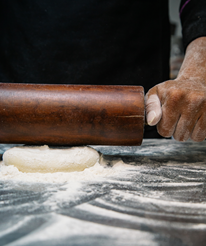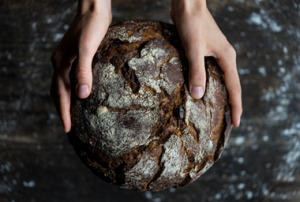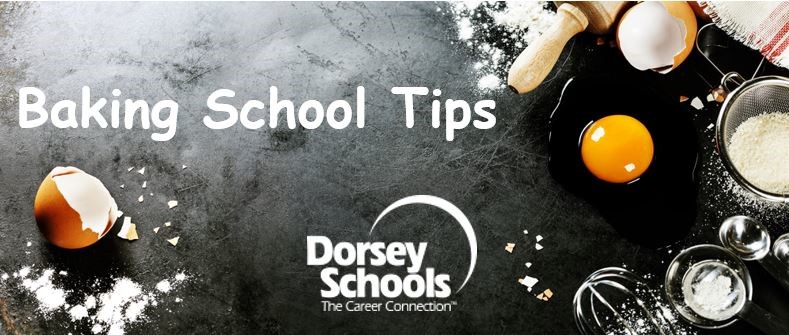Welcome to Baking and Pastry Arts School Tips! In these blogs, we explore various baking oriented topics to help take some of the guesswork out of your kitchen.
From bread to biscuits, cookies to cakes, baking is both an art and a science that involves turning flour into delicious food. Flour helps give structure to baked goods, and depending on the type of baked good, you may need different types of flour to create your delicious baked goods. Choose the right flour for your task and you’re on the road towards baking success; choose the wrong flour and you could be setting yourself up for a baking blunder. The tricky part is knowing the different types of flour (there are a lot) and their uses. In order to help you in telling the difference, we have compiled this list of some of the most commonly used flours and their baking purposes. Check them out!
- All-Purpose Flour – The name really says it all: This flour is great for just about everything! It is a mixture of hard and soft wheat and has a 10-12% protein. This means that the flour is sturdy enough to hold its structure in a yeasted bread and light enough to produce crumbs in a layer cake. Whether you’re baking yeasted cinnamon rolls or tender cupcakes, all-purpose flour should be your go to. If a recipe calls for “flour,” it’s calling for all-purpose flour. While not necessarily great for all purposes, it is the most versatile of flours.
- Bread Flour – Bread flour is designed specifically for yeasted baking (things like breads and pizza dough). It has a protein content of just under 13% which helps to create more gluten and more rise in baked breads. It’s a very sturdy flour which produces chewy crust.
Tip: Unbleached all-purpose flour can generally be substituted for bread flour with good results. - Cake Flour – Using cake flour in recipes creates the lightest cakes with the flakiest crumb. It is made from finely milled soft wheat and has 6-8% protein. There is a lack of gluten that ensures that cakes rise and come out especially fluffy. Cake flour is ideal for tender baked goods containing high amounts of sugar, such as cakes (of course), biscuits, muffins and scones.
- Pastry Flour – Pastry flour is also milled from a soft wheat and has a low gluten content. With protein levels somewhere between cake flour and all-purpose flour (8-9 %), pastry flour strikes the ideal balance between flakiness and tenderness, making it perfect for pie dough, biscuits, brownies, tarts and many cookies.
- Whole Wheat Flour – Whole wheat flour means business. It is made by milling the entire kernel of hard red wheat. It is darker in color, full of wheat and nutty flavors, and creates a more dense flavorful baked good. Whole-wheat flour is often used blended with all-purpose flour in recipes to lessen its strong wheat flavor and to give more rise. It has a high protein content (about 14%), higher fiber, nutritional and fat content. Try it in recipes for hearty and rustic breads.
Tip: Be sure to keep this flour stored in the refrigerator to avoid spoilage. - Self-Rising Flour – Long a Southern staple, self-rising flour is a biscuit maker’s dream! It is a softer, lower-protein (8.5%) flour that has salt and baking powder added to it. It’s best for making tender biscuits, muffins, pancakes and some cakes.
Tip: Self-rising flour is best stored tightly wrapped in its original box and used within six months of purchase — longer than that and the baking powder in it begins to lose its oomph. - Oat Flour – Oat flour is made from ground oats instead of wheat. This flour can be used in a wide variety of recipes, although it does carry a caution: it doesn’t behave like the other flours on this list because it doesn’t contain any gluten. If oat flour is used alone, baked goods will not rise or hold together; oat flour must be mixed with other flours in baking. It is most often used to make cookies, biscuits and pancakes. Oat flour can also be used as a good substitute for those with a gluten allergy (just make sure the oat flour you are using was made from gluten-free oats and it was made in an environment free from gluten).
While this is not a comprehensive list of ALL flour types out there, we did try to round up the most common types. We hope it will help you get a better understanding on these various flours and their uses. Now go and use your new found information to bake to your heart’s content. Happy Baking!
Baking and Pastry Arts training program at Dorsey Schools
The Baking and Pastry Arts diploma program at Dorsey Schools is designed to provide students with a “hands on” opportunity to learn, practice, understand and appreciate the skills needed to excel in the field of baking and pastry.
Various topics are taught within this program including (but not limited to):
- Knife skills
- Mise en place
- Basic food preparation
- Fundamentals of baking science
- Bread making
- Desserts and advanced pastries
- Plating, decorating, and sugar work
- Healthy baking and catering techniques
- Industry professionalism
- And more!
Interested in learning more about Dorsey Schools?
Does pursuing a career as a Baker or Pastry chef sound like the right path for you? If so, then give us a call at 888-422-1188 or Request Info Online.
Sources:
http://joythebaker.com/2014/05/baking-101-the-difference-between-baking-flours/
http://www.food.com/about/flour-64
http://www.foodnetwork.com/recipes/packages/baking-guide/flour-101-guide-to-different-types-and-uses.html?oc=linkback
http://www.huffingtonpost.com/2014/06/16/guide-to-baking-flours_n_1388420.html
http://www.wisegeek.com/what-is-oat-flour.htm

